Notes and Comments / Nouvelles brèves
Research Query:
Mobile Hanging Cradles
1 In the History Collection of the Canadian Museum of Civilization is an unusual bent-wood hanging cradle. The frame of this cradle has at one end a pair of cast iron wheels and at the other a small curved handle by which the bed may be pulled. Although the cradle was purchased in Gananoque, Ontario, and an almost identical one in the collection of the Canadian Centre for Folk Culture Studies at CMC was bought at Shakespeare, Ontario, near Stratford, a similar cradle is shown in Lyndon C. Viel, Antique Ethnic Furniture (Des Moines, Iowa: Wallace-Homestead, 1983) and is associated with the American Upper Midwest.
2 Mr. Viel refers to this latter cradle as a Norwegian "field" cradle, so named because it could be taken with the family to the fields during harvest. This interpretation seems to be improbable, at least with respect to the CMC History Collection cradle. An examination of that object demonstrates that the small cast iron wheels can lift the frame only a couple of inches off the ground, and the overall construction, while sturdy, is not robust. Not only could it not endure much rough treatment, there are no marks reflecting non-domestic use.
3 A picture of the CMC History Collection cradle published in the Ottawa Citizen as part of a feature on the Comforts of Home exhibit resulted in a contact from a local man who had a similar cradle in his possession. This cradle was used by the man's father as a baby. That information places the cradle in Ancaster, Ontario, around 1888. Other information from the Doon Heritage Crossroads collection in Waterloo, Ontario, indicates that they also have a very similar cradle, which they refer to as a "corn cradle."
 Display large image of Figure 1
Display large image of Figure 14 While all four Canadian cradles show some differences of construction in the frames, pulling handles and wheels, they are substantially similar. All appear to have been factory made and all but one have been decorated with yellow or gold pinstriping.
5 The Canadian Museum of Civilization would like to know more about possible origins and uses of these cradles. Readers with any information are invited to write or telephone Dr. Peter Rider, Atlantic Provinces Historian, telephone 819 776-8365, or Magnus Einarsson, North European Folklorist, 819 776-8226, Canadian Museum of Civilization, P.O. Box 3100, Station "B," Hull, Quebec, J8X 4H2.